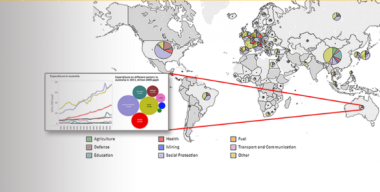The Statistics on Public Expenditures for Economic Development, sporting a catchy acronym SPEED, is an open access database managed by the International Food Policy Research Institute (IFPRI) with support from the CGIAR Research Program on Policies, Institutions, and Markets (PIM). It is also a user friendly interactive web tool allowing to view, compare, and download data on public expenditures from 147 countries from 1980-2012. The sectors include agriculture, education, defense, health, mining, social protection, fuel and energy, transport and communication. SPEED draws from multiple sources, including the International Monetary Fund, the World Bank, and national governments. The data is updated on a regular basis; spending measurements used in SPEED are consistent over time and free of exchange-rate fluctuations and currency denomination changes.
The latest edition of SPEED (third since 2010) and the updated data visualization tool were presented at IFPRI on May 19 during a seminar organized by the Development Strategy and Governance division. Samuel Benin, research fellow at IFPRI and SPEED project leader, talked about the historical and methodological background of SPEED, as well as the new features of the latest version. In his overview of SPEED applications he pointed out that the database has been widely used both by IFPRI colleagues and by external organizations including the World Bank, Food and Agriculture Organization of the United Nations (FAO), and a number of academic institutions. The topics analyzed with the help of SPEED included the composition of agricultural spending, effects of remittances on social spending, and the relationship of public spending with economic growth and productivity. Further planned improvements for SPEED include disaggregating data by economic use, disaggregating agricultural expenditures by sub-functions, and including new sectors and valuable sub-functions within sectors.
Nilam Prasai, who is managing SPEED’s online presence, provided an overview of the new visualization tool that allows users to quickly observe differences in sector prioritization in various countries on maps and charts, to analyze trends in spending, and much more. Yifei Liu, SPEED’s focal communications person, summarized the user statistics for SPEED: the number of downloads of the database reached about 800 downloads in 2015; most of the database users are academics, research institutes, and NGOs; the new data visualization tool has been viewed 749 times since its launch in March 2016.
If you have any questions about SPEED, contact Samuel Benin at IFPRI-SPEED@cgiar.org
Presentation
Webinar recording



